Highlights from the Inaugural Retail Bonfire Event
The Coresight Research team cohosted the inaugural Retail Bonfire event with Salesforce in New York City last week. Nearly 200 people attended the event, which offered inspiration, insights and fireside chats with industry leaders. Coresight Research CEO and Founder Deborah Weinswig and Salesforce VP of Industry Strategy and Insights Rob Garf kicked off the event with brief presentations. Weinswig discussed the current state of retail and Garf summarized a recent research report by Salesforce and its research partner, Publicis.Sapient, called
Shopper-First Retailing, which lays out three mandates for retailers, from the point of view of shoppers: “make it fresh,” “be where I am” and “give it meaning.”
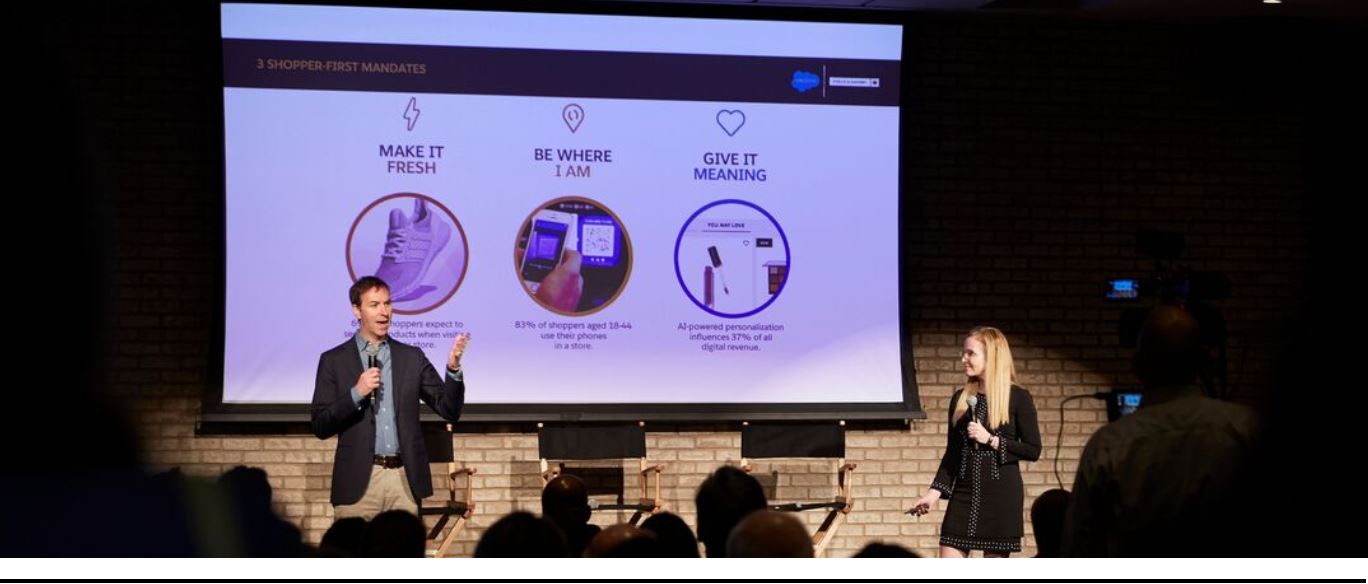 Rob Garf, VP of Industry Strategy and Insights, Salesforce, and Deborah Weinswig, CEO and Founder, Coresight Research
Source: Coresight Research
Rob Garf, VP of Industry Strategy and Insights, Salesforce, and Deborah Weinswig, CEO and Founder, Coresight Research
Source: Coresight Research
Retail is growing, yet it remains challenged, with retailers being squeezed between brands and marketplaces and valued based on their customer service.
Deborah Weinswig kicked off the event with a presentation on the current state of retail, noting that:
- Retail is growing: Total US retail sales grew at a healthy 5.7% clip during the second quarter of this year, according to US Department of Commerce data, and e-commerce sales grew at an even healthier 15%. In-store sales grew at a slower 4.8%. Garf commented that the current environment doesn’t feel like a “retail apocalypse,” even though so many have characterized it as that.
- Retail is challenged: Despite this growth, there have been 5,006 US store closures announced thus far this year, compared with more than 8,000 in all of 2017. At the same time, Amazon accounts for more than 80% of e-commerce growth. Weinswig commented that at the recent ICSC RECon conference, landlords were jokingly observing that covered boxes had better rents and foot traffic. Garf mentioned that one former pure-play retailer had seen its physical store perform strongly and drive customer affinity.
- Retailers are squeezed: Consumers highly value customer service, and retailers are being squeezed between brands (which consumers value in terms of product quality, innovation and uniqueness) and marketplaces (which they value in terms of price, variety, availability and inspiration).
According to Salesforce’s Shopper-First Retailing report, consumers have given retailers three mandates: “make it fresh,” “be where I am” and “give it meaning.”
Rob Garf described how Salesforce and its research partner, Publicis.Sapient, produced the
Shopper-First Retailing report in an effort to find the “true story of shopping.” The report was based on three main sources of information:
- Shopper activity: The Salesforce Commerce Cloud handles 500 million shoppers monthly, and its Service Cloud handles more than 200 million service cases.
- Consumer survey: Salesforce conducted a survey of 6,000 shoppers, 1,000 each in the US, Canada, the UK, France, Germany and Australia.
- Mystery shopping: The Salesforce team visited 70 physical stores in New York City, London and San Francisco and rated them on store details, mobile features and loyalty program mentions.
The research revealed three mandates for retailers from the point of view of shoppers:
- “Make it fresh”: Some 69% of shoppers expect to see new products when visiting a website or store. Consumers want to see fresh products and have new experiences every time they enter a store.
- “Be where I am”: Some 83% of shoppers ages 18–44 use their phone when they are in a store. Retailers need to promote their brand wherever the consumer is, whether that is on a marketplace site or an app.
- “Give it meaning”: Artificial intelligence-powered personalization influences 37% of all digital revenue. Technologies such as augmented reality can help a retailer build a special connection with customers, and customers are willing to pay a premium for this connection.
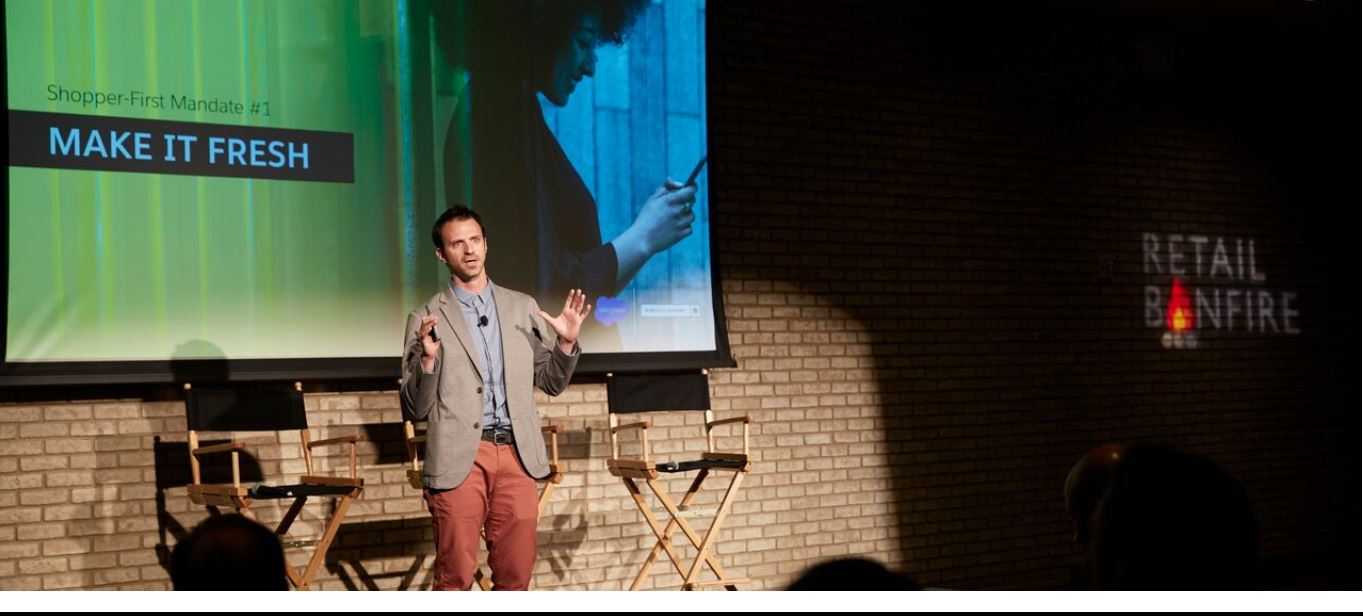 Rick Kenney, Head of Consumer Insights, Salesforce
Source: Coresight Research
Rick Kenney, Head of Consumer Insights, Salesforce
Source: Coresight Research
“Make it fresh” involves constantly renewing products, acting with urgency and developing unique products.
Rick Kenney, Head of Consumer Insights at Salesforce, presented on the meaning of the “make it fresh” mandate:
- Constantly renewing products: Despite the emergence of fast fashion, shoppers remain eager for constant newness. Some 69% of shoppers expect to see new merchandise on each visit, whether they are in a store or on an e-commerce site, and not just in fashion categories, but across retail brands. This is “fresh retail.” The top 5% of the product catalog generates 48% of revenue, yet 59% of this top 5% of products changes monthly, according to Salesforce.
- Acting with urgency: As with the news cycle and consumers’ constant craving for content, shopping cycles are accelerating and shoppers are constantly seeking newness. Due to marketplace migration, many shoppers who make their first purchase at a retailer are more likely to make repeat purchases on a marketplace. This affects retailers’ calculation of the customer acquisition cost, since it is based on the customer’s lifetime value and the possibility that the customer may go to a marketplace and never return. Moreover, half of repeat buyers make their second purchase within 16 days of their initial purchase.
- Developing unique products: Brands and retailers that can deliver unique products are positioned to survive the chaos and turmoil of a hypercompetitive market. Shoppers demand unique, exclusive offerings and are more likely to buy if brands offer collaborations with influencers or other brands, limited-edition products, or customized products.
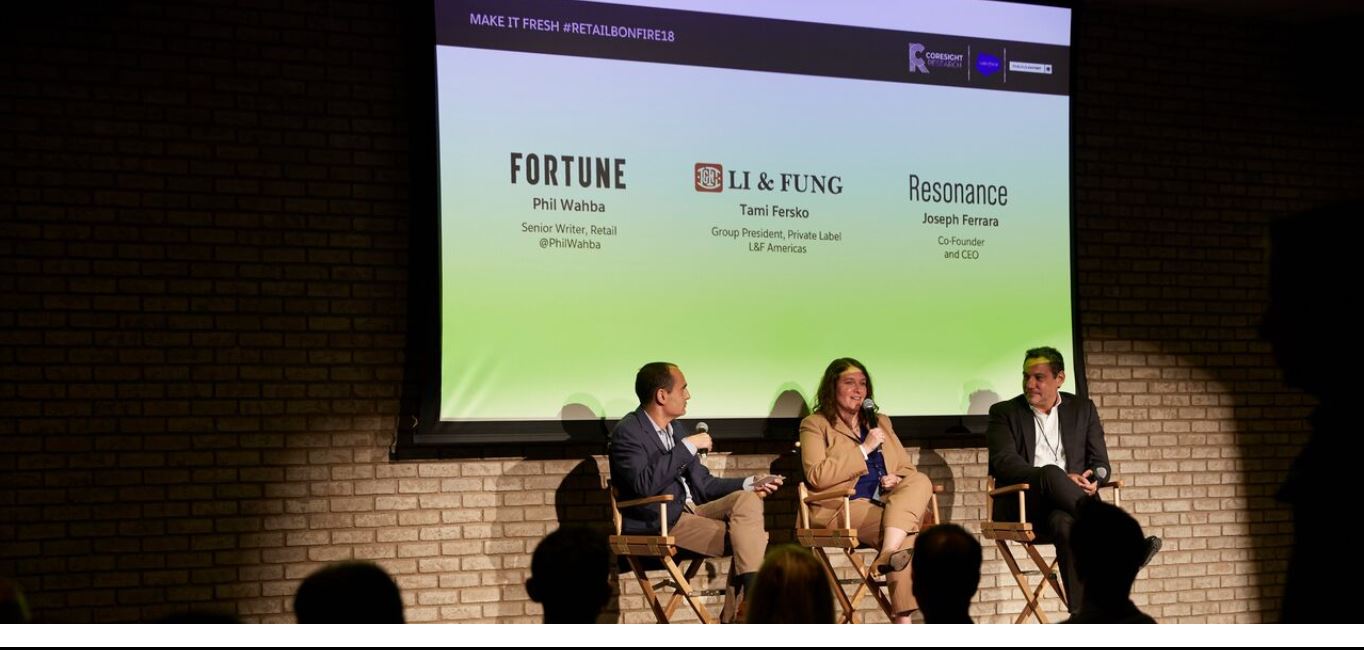 Left to right: Phil Wahba, Senior Writer, Retail, Fortune; Tami Fersko, Group President, Private Label, LF Americas; Joseph Ferrara, Co-founder and CEO, Resonance
Source: Coresight Research
Left to right: Phil Wahba, Senior Writer, Retail, Fortune; Tami Fersko, Group President, Private Label, LF Americas; Joseph Ferrara, Co-founder and CEO, Resonance
Source: Coresight Research
Panel Discussion
Moderator: Phil Wahba, Senior Writer, Retail,
Fortune
Panelists: Tami Fersko, Group President, Private Label, LF Americas, and Joseph Ferrara, Co-founder and CEO, Resonance
Joe Ferrara discussed how his company, Resonance, invests in brands. Each brand in Resonance’s $200 million portfolio has less than $10 million in sales. His company is “keeping it fresh” via constant new product introductions and collaborations with celebrities. Tami Fersko of LF Americas discussed the challenges of navigating the digital economy, noting that apparel brands aim to create experiences, but still keep apparel affordable. She discussed the concept of offering 52 new collections a year (i.e., weekly collections), and said that new digital tools have unleashed designers’ creativity and that designers have found these tools liberating. Fersko also spoke about how Li & Fung has used digital design tools to reduce development cycle time by 30%–50%, although the length of the production cycle remains essentially the same.
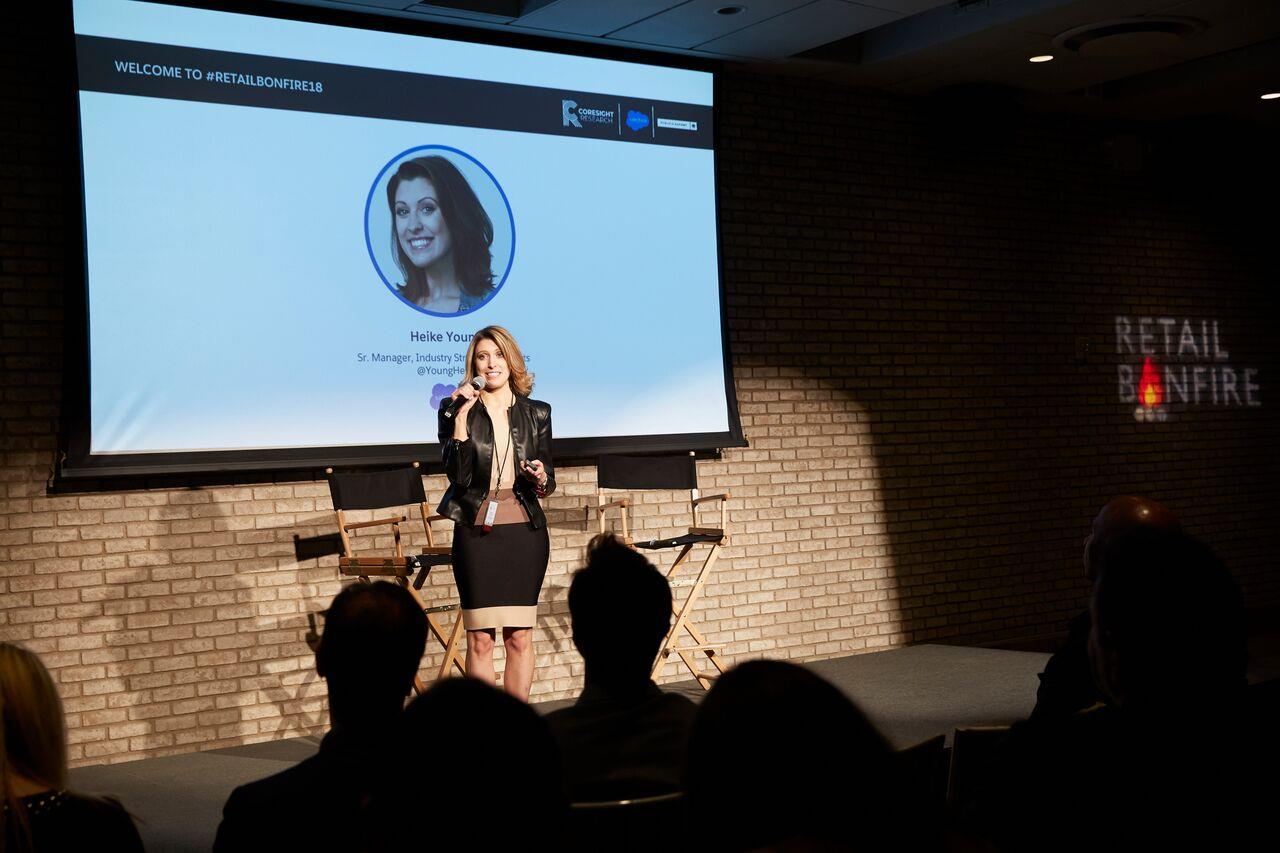 Heike Young, Senior Manager of Industry Strategy & Insights, Salesforce
Source: Coresight Research
Heike Young, Senior Manager of Industry Strategy & Insights, Salesforce
Source: Coresight Research
“Be where I am” means leveraging mobile to communicate with consumers both outside and inside stores.
Heike Young, Senior Manager of Industry Strategy & Insights at Salesforce, presented on the “be where I am” mandate. She began by sharing a graph that showed that mobile e-commerce traffic first eclipsed desktop traffic in 2015 and that it accounted for 63% of traffic in the third quarter of 2018. She noted that mobile traffic has grown to 4% of order share, whereas tablets’ share has remained under 20%. Looking at demographic groups, Young said that baby boomers, Gen Xers and millennials all generally favor making purchases in a physical store, but that millennials vastly dominate in terms of phone usage, and that all three groups use PCs and laptops. Some 71% of consumers surveyed use a mobile device when shopping in a store, Young said. She also noted that voice-powered shopping has been the subject of much hype, and that 70% of smart speaker owners had used voice for at least one shopping activity within the past three months.
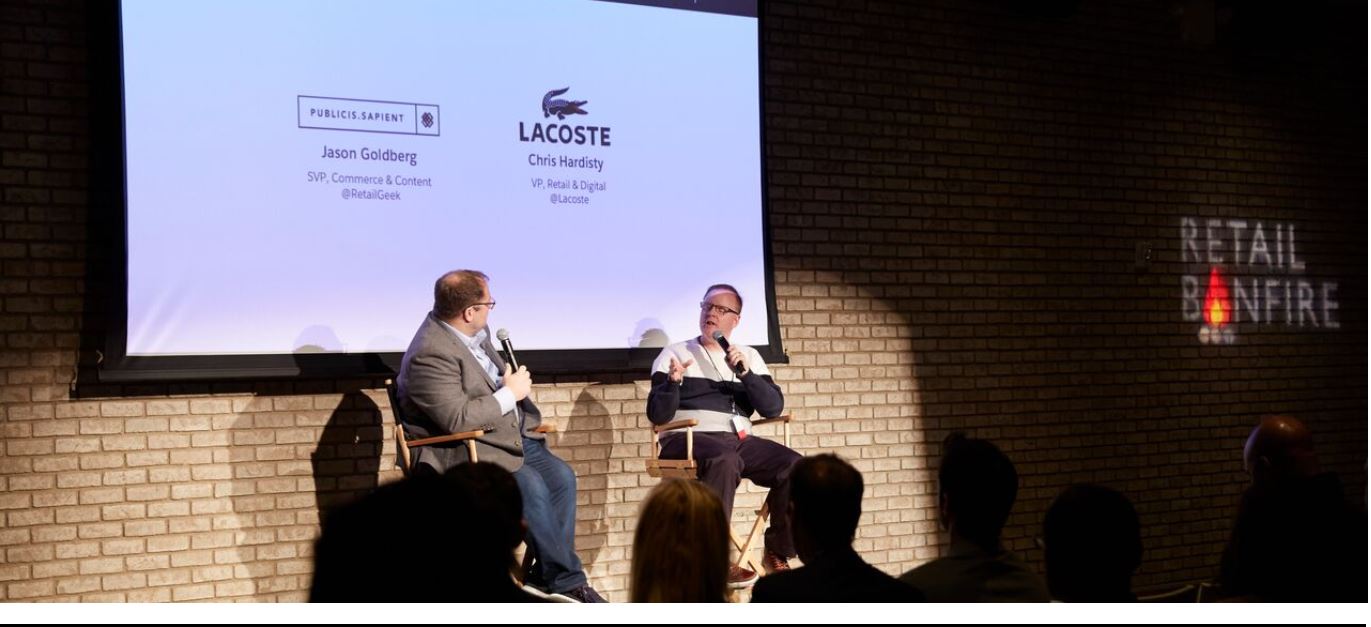 Jason Goldberg, SVP, Commerce & Content, Publicis.Sapient, and Chris Hardisty, Lacoste
Source: Coresight Research
Jason Goldberg, SVP, Commerce & Content, Publicis.Sapient, and Chris Hardisty, Lacoste
Source: Coresight Research
Interview
Interviewer: Jason Goldberg, SVP, Commerce & Content, Publicis.Sapient
Interviewee: Chris Hardisty, Lacoste
Chris Hardisty of Lacoste discussed retail technologies and described the state of voice shopping today as being similar to where e-commerce was 20 years ago. He said that although voice shopping would not be able to replace a real human connection, it still has huge potential to do many other things. For example, voice shopping combined with a visual component could help shoppers pick the right size and color dress, he said.
Hardisty also shared how his company handles mobile usage in its stores. He said that Lacoste approaches the issue in three steps:
1) Encourage the team to embrace mobile in-store.
2) Educate customers to help them understand why products are good via premium prices.
3) Aim for customers to be happier after visiting a store.
Finally, the discussion turned to social media for retail. Hardisty talked about Lacoste’s success in leveraging the power of social media and said that it is a good place for consumers to interact with brands and that he believes there are many opportunities to leverage social media.
 Jason Goldberg, SVP, Commerce & Content, Publicis.Sapient
Source: Coresight Research
Jason Goldberg, SVP, Commerce & Content, Publicis.Sapient
Source: Coresight Research
Retailers can “give it meaning” by stressing values, loyalty and personalization.
Jason Goldberg then gave a presentation that offered three ways to give meaning to retail: values, loyalty and personalization. Of these three, personalization typically receives the most attention, and Goldberg told the success story of London-based Lock & Co. Hatters, the oldest retailer in the world. The retailer’s early success was built on offering custom hats that were ordered by recognizing the customer’s voice when he or she shouted out an order when passing the shop.
Goldberg also discussed the progression of marketing, from one to one (with a unique experience for each customer) to one to many (with the same experience for every customer) to segmented (offering different experiences for groups of customers). While 21% of firms surveyed stated that they have completed their digital transformation, Goldberg noted that many have not yet cracked the digital marketing code, sharing a personal example of an airline (where he is a frequent flyer) that blasts him with irrelevant offers. He noted that shoppers remain open to personalized recommendations: 55%–68% of shoppers (depending on demographic) surveyed strongly agree that they like it when a retailer provides product recommendations based on their purchasing history, Goldberg said.
In terms of values, Goldberg said that 55% of millennials surveyed agree or strongly agree that they are most likely to buy from a brand or retailer that offers a charitable donation with a purchase. Gen Xers and baby boomers responded positively to the same question, he said, with 42% and 31%, respectively, agreeing or strongly agreeing.
Looking at loyalty, Goldberg noted that a survey found that 72% of millennials, 68% of Gen Xers and 57% of baby boomers are likely or more likely to buy from a company that offers a loyalty program.
 Left to right: Phil Wahba, Senior Writer, Retail, Fortune; Katy Gaul-Stigge, CEO, Goodwill Industries of Greater New York and Northern New Jersey; Susan Jones, Cofounder and COO, Care+Wear
Source: Coresight Research
Left to right: Phil Wahba, Senior Writer, Retail, Fortune; Katy Gaul-Stigge, CEO, Goodwill Industries of Greater New York and Northern New Jersey; Susan Jones, Cofounder and COO, Care+Wear
Source: Coresight Research
Panel Discussion
Moderator: Phil Wahba, Senior Writer, Retail, Fortune
Panelists: Katy Gaul-Stigge, CEO, Goodwill Industries of Greater New York and Northern New Jersey, and Susan Jones, Cofounder and COO, Care+Wear
Goodwill’s vision is for a world with no barriers to employment and the organization endeavors to keep jobs, find jobs and create jobs in its stores. Care+Wear works with clinicians and patients to offer innovative products. In a panel with Goodwill CEO Katy Gaul-Stigge and Care+Wear COO Susan Jones, moderator Phil Wahba asked whether customers really care about companies that try to do good while offering products. Gaul-Stigge responded that Goodwill’s customers do care about the organization’s mission and understand that it does good by creating jobs, running mental health clinics and helping disabled people keep jobs with the help of a job coach. Jones responded similarly, commenting that Care+Wear works with partners and designers on a give-back plan.
Looking at demographics, the panelists noted that millennials ask more questions and are interested in sustainability. Both Gaul-Stigge and Jones discussed ways to reach customers by embracing social media, holding pop-up events and providing personal outreach to customers.

 Rob Garf, VP of Industry Strategy and Insights, Salesforce, and Deborah Weinswig, CEO and Founder, Coresight Research
Source: Coresight Research
Rob Garf, VP of Industry Strategy and Insights, Salesforce, and Deborah Weinswig, CEO and Founder, Coresight Research
Source: Coresight Research Rick Kenney, Head of Consumer Insights, Salesforce
Source: Coresight Research
Rick Kenney, Head of Consumer Insights, Salesforce
Source: Coresight Research Left to right: Phil Wahba, Senior Writer, Retail, Fortune; Tami Fersko, Group President, Private Label, LF Americas; Joseph Ferrara, Co-founder and CEO, Resonance
Source: Coresight Research
Left to right: Phil Wahba, Senior Writer, Retail, Fortune; Tami Fersko, Group President, Private Label, LF Americas; Joseph Ferrara, Co-founder and CEO, Resonance
Source: Coresight Research Heike Young, Senior Manager of Industry Strategy & Insights, Salesforce
Source: Coresight Research
Heike Young, Senior Manager of Industry Strategy & Insights, Salesforce
Source: Coresight Research Jason Goldberg, SVP, Commerce & Content, Publicis.Sapient, and Chris Hardisty, Lacoste
Source: Coresight Research
Jason Goldberg, SVP, Commerce & Content, Publicis.Sapient, and Chris Hardisty, Lacoste
Source: Coresight Research Jason Goldberg, SVP, Commerce & Content, Publicis.Sapient
Source: Coresight Research
Jason Goldberg, SVP, Commerce & Content, Publicis.Sapient
Source: Coresight Research Left to right: Phil Wahba, Senior Writer, Retail, Fortune; Katy Gaul-Stigge, CEO, Goodwill Industries of Greater New York and Northern New Jersey; Susan Jones, Cofounder and COO, Care+Wear
Source: Coresight Research
Left to right: Phil Wahba, Senior Writer, Retail, Fortune; Katy Gaul-Stigge, CEO, Goodwill Industries of Greater New York and Northern New Jersey; Susan Jones, Cofounder and COO, Care+Wear
Source: Coresight Research